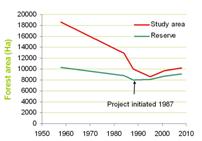
Studies of the vegetation cover of Mount Oku IBA in north-west Cameroon, last stronghold for Bannerman’s Turaco and Banded Wattle-eye (both Endangered), have shown that, as a result of a community-managed forest project, there has been significant regeneration of forest in the past fifteen years.

Mount Oku (also known as Kilum–Ijim), an Important Bird Area in the Bamenda Highlands of north-western Cameroon, holds the largest remaining populations of two globally threatened bird species, Bannerman’s Turaco Tauraco bannermani and Banded Wattle-eye Platysteira laticincta (both Endangered). These two species, along with others confined to the Cameroon highlands, are threatened by the loss of their montane forest habitat to agriculture. In response to the continuing rapid deforestation, BirdLife initiated a community-managed forest project on Mount Oku in 1987. The project has been working with local people to:

Local communities, enabled by recent legislation and supported by the Government of Cameroon and the project, now legally manage three-quarters of the forest while applications to bring the remaining area under similar management are pending.

Recent studies of changes in forest cover on Mount Oku, using satellite imagery and aerial photographs, have revealed strong regeneration since 1988, soon after the project started. From 1995, the rate of regeneration (c.2.3% per year) has significantly exceeded the rate of deforestation (see figure). This reversal is a tribute to the success of local people in taking action to conserve their natural resources. It clearly also benefits the unique biodiversity found in the region. The project at Mount Oku shows that the conservation of natural resources can be compatible with the conservation of biodiversity at the local scale.
Related Sites
Related Species
Compiled: 2004 Last updated: 2008
Recommended Citation:
BirdLife International (2008)
Community management of forest on Mount Oku, Cameroon, has led to significant habitat regeneration.
Downloaded from https://datazone.birdlife.org/sowb/casestudy/community-management-of-forest-on-mount-oku-cameroon-has-led-to-significant-habitat-regeneration on 22/12/2024